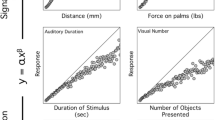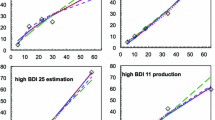Abstract
To take account of the observed lack of fit of the power law near thresh-old intensities, two different modifications of the power law have been proposed by various investigators. In this paper, both of these two laws are derived as a special case of a generalized power function for ratio scaling. A method is presented for discriminating between the special laws which provides (i) a prescription for the manipulation of independent variables, and (ii) specification of theoretical curves to which empirical curves are to be compared. Maximum-likelihood estimators are derived for the exponents of the special laws under the assumption that the observed subjective ratios are log normal.
Similar content being viewed by others
References
Ekman, G. Two generalized ratio scaling methods.J. Psychol., 1958,45, 287–295.
Ekman, G. and Sjoberg, L. Scaling.Ann. Rev. Psychol., 1965,16, 451–474.
Fagot, R. F. On the psychophysical law and estimation procedures in psychophysical scaling.Psychometrika, 1963,28, 145–160.
Galanter, E. and Messick, S. The relation between category and magnitude scales of loudness.Psychol. Rev., 1961,68, 363–372.
Hellman, R. P. and Zwislocki, J. Some factors affecting the estimation of loudness.J. acoust. Soc. Amer., 1961,33, 687–694.
Lindgren, B.Statistical theory. New York: Macmillan, 1962.
Lochner, J. P. A. and Burger, J. F. Form of the loudness function in the presence of masking noise.J. acoust. Soc. Amer., 1961.33, 1705–1707.
Luce, R. D. On the possible psychophysical laws.Psychol. Rev., 1959,66, 81–95.
Mashhour, M. On fitting some curvilinear functions to experimental data. Technical Report No. 131, Psychological Laboratory, Univ. Stockholm, September, 1962.
McGill, W. A. The slope of the loudness function: A puzzle. In H. Gulliksen and S. Messick (Eds.),Psychological scaling: theory and applications. New York: Wiley, 1960.
Scharf, B. and Stevens, J. C. The form of the loudness function near threshold.Proc. third internat. Congr. Acoust., Stuttgart, Germany, 1959.
Stevens, S. S. Tactile vibration: Dynamics of sensory intensity.J. exp. Psychol., 1959,59, 210–218.
Stevens, S. S. Measurement, psychophysics, and utility. In C. W. Churchman and P. Ratoosh (Eds.),Measurement: definitions and theories. New York: Wiley, 1959.
Stevens, S. S. and Galanter, E. H. Ratio scales and category scales for a dozen perceptual continua.J. Exp. Psychol., 1957,54, 377–411.
Zwislocki, J. and Hellman, R. On the psychophysical law.J. acoust. Soc. Amer., 1960,32, 924.
Author information
Authors and Affiliations
Additional information
This research was supported in part by National Science Foundation Grant G19210 and in part by a Public Health Service Special Fellowship (No. MSP-15800), from the National Institutes of Health, Public Health Service. During the tenure of this fellowship, facilities of the Institute for Human Learning, University of California, Berkeley, were made available to me. The computing was carried out at the University of California Computer Center and the University of Oregon Statistical Laboratory and Computing Center. I have benefited appreciably from numerous discussions of this research with Manard Stewart.
Rights and permissions
About this article
Cite this article
Fagot, R.F. Alternative power laws for ratio scaling. Psychometrika 31, 201–214 (1966). https://doi.org/10.1007/BF02289507
Received:
Revised:
Issue Date:
DOI: https://doi.org/10.1007/BF02289507




